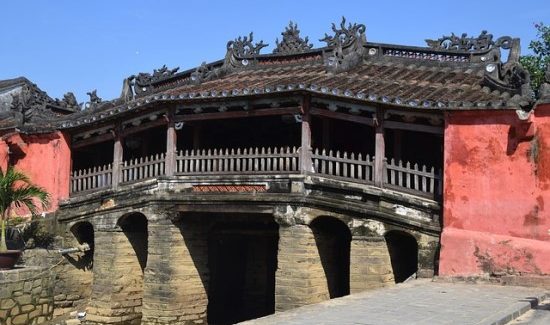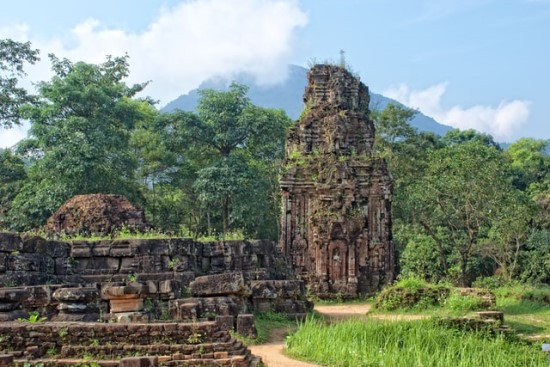Menu
Beautifully preserved and offering plenty of things to do, see and eat, Hoi An is famous for its laidback atmosphere and wonderful architecture. The town’s architecture boasts a fusion of Vietnamese, Japanese, Chinese and European influences dating back to the 16th century. Formerly a rich trading port, in its hey day vessels swarmed here from all over the world, from Portuguese sailors to wealthy Japanese merchants. Today, thanks to successful conservation efforts, the town, unlike the rest of Vietnam, feels frozen in time. Colorful lanterns shimmer above the cobblestone streets of the Old Town and the mustard-yellow facades of villas and shophouses welcome visitors to swanky cafes, exquisite restaurants and art galleries. In Vietnam, Hoi An is a synonym with arts and crafts, particularly with couture, as the city is notable for its many tailors.
Granted UNESCO World Heritage status in 1999, Hoi An is today an unmissable stop in the Vietnam travel route.

The options for sightseeing and entertainment in this city are endless. One could spend a couple of days without getting tired of wandering through the cobblestone alleys of Hoi An’s old town. Here are some of the highlights of the old city:
A small arch-bridge of red-painted wood, popularly known as the Japanese Covered Bridge, adorns the western extremity of Tran Phu street. The bridge is the city’s emblem and even appears on the twenty thousand dong banknote. The peculiar covered bridge dates back to the sixteenth century. Legend has it that its purpose, besides crossing the muddy creek underneath, was to neutralize a restless monster that had caused several strong earthquakes in Japan and whose heart was located in Hoi An.
It’s a pleasant bike ride or hike to the beaches of Cua Dai or An Bang. Today, everything from cosy homestays to luxury resorts line the white sands of both beaches, while their most popular stretches offer full services, including restaurants, bars, umbrellas and some water sports. If you want to enjoy the beach at its prime, best visit from March to September.
Vietnam’s largest Cham site, My Son lies 40km southwest of Hoi An. The rulers of the nearby Champa capital of Simhapura established the site to worship the god Shiva. Excavations at My Son have revealed that Cham Kings were buried here as early as the fourth century. At one time, the site encompassed over 70 temples as well as numerous stele bearing historically important inscriptions in Sanskrit and Cham. The Mỹ Sơn temple complex is one of the foremost Hindu temple complexes in Southeast Asia, often dubbed the Angkor of Vietnam. As of 1999, Mỹ Sơn has been recognized by UNESCO as a world heritage site.

Hoi An’s central market retains its authenticity despite the city’s renewed popularity with overseas travelers. Best visited in the early morning, the market holds many of the local specialities and it is one of the best spots to turn on your Anthony Bourdain and try some of the best street food the city has to offer.
Of the various Chinese assembly halls that dot Hoi An, we can recommend a visit to the Cantonese House of Quảng Đông, because of its aesthetic appeal and for being one of the least visited assembly halls in the city. Built in 1855 by the Cantonese community that populated the city, the house holds a temple honoring a warrior named Quan Cong and the goddess of the sea Thien Hau.
Relax on a sunset boat trip along the Thu Bon River in Hoi An. The boat may stop along the shore so you can watch how the locals catch fish with traditional fishing nets as well as seeing local life on the river bank. See the city on the back of a Vespa, exploring Hoi An’s culture, local cuisine and rural life. Cycle to Tra Que village and observe local farmers working the organic fields using traditional methods that date back hundreds of years. Perhaps the most special experience is riding a water buffalo with local farmers and embarking on a lovely boat trip visiting coastal fishing villages whilst jumping into bamboo basket boat during the visit.
Cycling to Tra Que vegetable village named after a sweet-scented herbs grown here, and used to flavor Hoi An specialties like Cao Lau noodles. Observe local farmers working the organic fields using traditional methods that date back hundreds of years. Stroll around Ba Le market before winding your way to Cam Thanh village, a local fishing village with charming ocean views, many kumquat gardens and corn fields. Experience a short trip in a traditional round basket boat back to Hoi An.
A countryside ride by bicycle from the outskirts of Hoi An to village life, hop on and try riding a water buffalo with farmers. Head to visit a local bamboo handicraft place before going to Cam Thanh village and resting. We’ll embark on a boat trip to visit the coastal fishing villa in Cua Dai where we will take part in a traditional fishing activity with local fishermen. When we’re there we will hop on a Vietnamese bamboo basket boat, a great place to make very fun memories and have a great laugh. Catch some crabs with the locals and head back to enjoy lunch or dinner (depending on your time slot) at a local’s house. We will then head back to the hotel.